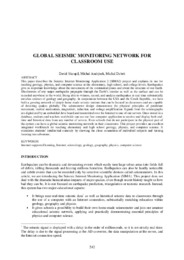| dc.contributor.author | Skoupil, David | en |
| dc.contributor.author | Andrýsek, Michal | en |
| dc.contributor.author | Dobeš, Michal | en |
| dc.coverage.spatial | CY - Λευκωσία | en |
| dc.creator | Skoupil, David | en |
| dc.creator | Andrýsek, Michal | en |
| dc.creator | Dobeš, Michal | en |
| dc.date.accessioned | 2016-02-08T10:17:56Z | |
| dc.date.available | 2016-02-08T10:17:56Z | |
| dc.date.issued | 2005 | |
| dc.identifier.uri | http://hdl.handle.net/10797/14611 | en |
| dc.description | Περιέχει το πλήρες κείμενο | el |
| dc.description.abstract | This paper describes the Seismic Internet Monitoring Application 2 (SIMA2) project and explains its use for teaching geology, physics, and computer science at the elementary, high school, and college levels. Earthquakes give us important knowledge about the movements of the continental plates and about the structure of our Earth. Shockwaves of any major earthquake propagate through the Earth’s interior as well as the surface and can be recorded anywhere in the world. Being able to witness, record, and analyze earthquakes in real time substantially enriches courses of geology and geography. In cooperation between the USA and the Czech Republic, we have built a growing network of simple home made seismic stations that can be located in classrooms and are capable of detecting quakes globally. The seismometer design demonstrates the physical principles of pendulum movement, inertial momentum, magnetism, induction, and voltage amplification. Signals from the seismographs are digitalized by an embedded Java board and transmitted over the Internet to one of our servers. Once stored in a database, students and teachers worldwide can use our free computer application to receive and display both real-time and historical data from any number of servers. Even schools that do not participate in the physical part of the system can have a global seismic monitoring network in their classrooms. This project provides an excellent integrated workbench for teaching elementary and high school geology, physics, and computer science. It stimulates students’ intellectual curiosity by showing the close connection of individual subjects and turning learning into adventure. | en |
| dc.language.iso | eng | en |
| dc.publisher | University of Zilina | en |
| dc.relation.ispartof | Information and communication technology | en |
| dc.rights | info:eu-repo/semantics/openAccess | en |
| dc.rights | Open Access | en |
| dc.source | CBLIS Conference Proceedings 2005 Integrating New Technologies in Science and Education | en |
| dc.title | Global seismic monitoring network for classroom use | en |
| dc.type | info:eu-repo/semantics/conferenceObject | en |
| dc.subject.uncontrolledterm | Internet-supported learning | en |
| dc.subject.uncontrolledterm | Internet, seismology | en |
| dc.subject.uncontrolledterm | Geology | en |
| dc.subject.uncontrolledterm | Geography | en |
| dc.subject.uncontrolledterm | Physics | en |
| dc.subject.uncontrolledterm | Computer science | en |
| dc.contributor.conferenceorganizer | Learning in Science Group, University of Cyprus | en |
| dc.contributor.coordinator | Constantinou, Constantinos P. | en |
